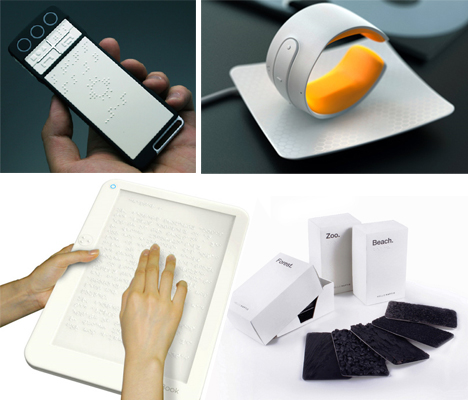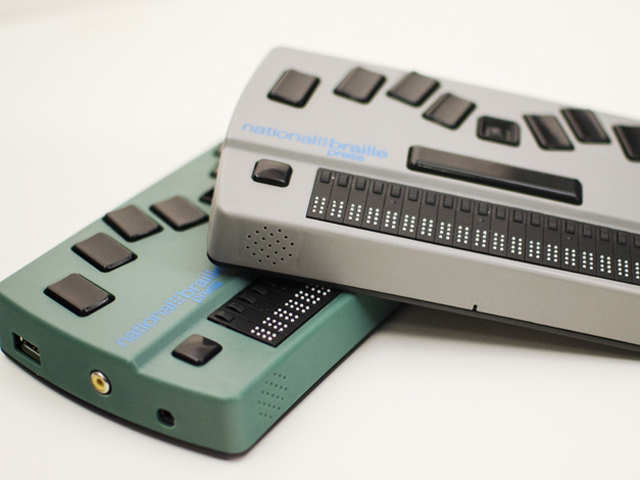Discover Innovative Devices Made for the Aesthetically Impaired
The development of cutting-edge tools for the visually damaged stands for a significant advancement in accessibility and self-reliance. Technologies such as smart glasses with AI capabilities and mobile applications made to give acoustic descriptions are reshaping daily experiences for users. Additionally, wearable gadgets that employ haptic feedback boost environmental recognition, while contemporary Braille developments supply new means to engage with message. As these tools proceed to develop, their influence on the lives of those with aesthetic disabilities elevates vital concerns about the future of inclusivity and autonomy in different facets of life. What exists ahead in this technological landscape?
Smart Glasses for Navigation

Smart glasses created for navigating are transforming the way aesthetically impaired people engage with their environment. These innovative gadgets utilize a combination of cam technology, artificial knowledge, and auditory responses to offer real-time information about environments. By utilizing barrier discovery systems, wise glasses can signal customers to prospective risks, enabling more secure movement in both unfamiliar and acquainted settings.
The combination of GPS modern technology additionally boosts navigating capabilities, enabling individuals to obtain auditory directions as they relocate. This hands-free strategy not just promotes independence but likewise equips visually impaired individuals to navigate city landscapes with enhanced confidence. In addition, numerous smart glasses are outfitted with functions that recognize landmarks and road indications, giving contextual details that improves the user experience.
In addition, the growth of these devices is consistently advancing, with companies functioning to boost the precision of things recognition and increase the variety of navigational functions. As clever glasses end up being extra cost effective and accessible, they hold the possible to significantly transform every day life for aesthetically impaired customers. Ultimately, these innovative devices represent an important action toward inclusivity, offering enhanced flexibility and a higher feeling of autonomy for people browsing the world around them.

Mobile Application for Daily Living
Just how can mobile applications enhance the every day lives of aesthetically impaired individuals? Mobile applications are changing the way visually impaired individuals browse their settings, manage everyday jobs, and gain access to info. These applications give necessary assistance via various performances, fostering independence and improving lifestyle.
Numerous cutting-edge mobile apps are designed specifically for everyday living. For example, applications like Be My Eyes connect visually damaged customers with sighted volunteers via video telephone calls, allowing them to get real-time aid with tasks such as checking out labels or navigating strange areas. Seeing AI, developed by Microsoft, utilizes synthetic intelligence to explain environments, read text, and determine objects, effectively transforming a mobile phone into an effective tool for daily help.
In addition, navigation applications tailored for the visually damaged, such as Aira and BlindSquare, offer audio-based directions and environmental details, making it possible for individuals to traverse their surroundings securely and confidently. Beyond navigation and instant assistance, mobile apps additionally support company and task management, with features that assist customers set tips, produce to-do lists, and track consultations. In recap, mobile applications offer as indispensable resources, empowering aesthetically impaired people to lead even more independent and fulfilling lives.
Wearable Technologies for Help
Empowerment with modern technology is significantly apparent in the world of wearable devices made to assist aesthetically damaged people. These innovative tools integrate effortlessly right into daily life, improving navigating and page providing essential responses to customers. Smart best color blind glasses glasses furnished with cams can review and acknowledge faces text aloud, enabling individuals to connect even more with confidence in social and professional setups.
One more notable advancement is using haptic feedback systems in wearable gadgets. These systems utilize resonances or various other tactile signals to communicate details about the individual's environment, such as barriers or adjustments in surface, improving wheelchair and security. Wearable modern technologies also consist of wristbands that connect to mobile phones, informing individuals to alerts through refined vibrations, hence enhancing connectivity without dependence on aesthetic cues.
As these technologies proceed to progress, they are not only enhancing freedom for visually impaired people however likewise cultivating a greater feeling of addition in culture. By linking the gap in between challenges dealt with in daily living and the possibility for freedom, wearable modern technologies serve as pivotal devices in the quest for equal rights and empowerment for those with visual impairments.
Sound Summary Devices
Sound summary devices play an important duty in boosting ease of access for visually impaired individuals, supplying them with the capability to involve with visual media. Wearable technology for low vision. These tools supply narrated summaries of key aesthetic aspects in films, tv shows, and live efficiencies, making certain that customers can totally comprehend the context and feelings shared with visuals
Sound summary can be incorporated into various systems, including streaming services, cinema testings, and live cinema. Numerous prominent streaming solutions now consist of audio summary as an ease of access feature, allowing customers to choose it quickly. Along with mainstream media, specialized apps additionally exist, offering audio summaries for art events, museums, and other cultural occasions.
The efficiency of audio summary pivots on the skill of the storytellers, that need to communicate aesthetic information succinctly without taking away from the original audio. Innovations in this area are also paving the method for more tailored experiences, where customers can Our site readjust the level of information and pacing according to their choices.
Braille Innovations and Gadgets
Braille advancements and tools have actually considerably transformed the method visually damaged individuals connect with message and information. Modern advancements have led to the advancement of versatile devices that improve literacy and freedom among users.
Furthermore, portable Braille notetakers combine conventional Braille input with contemporary performances, assisting in note-taking, organizing, and paper modifying on the go. AI-powered visual aids. These small tools commonly include text-to-speech abilities, linking the void in between Braille and auditory info
Furthermore, cutting-edge Braille printers have actually emerged, enabling individuals to generate Braille labels, records, and academic products successfully. This ease of access fosters better involvement in instructional and specialist atmospheres, eventually promoting inclusivity.
Moreover, research study into clever Braille modern technologies continues to expand. Instruments that include synthetic intelligence are being checked out to give real-time navigating help and contextual details, enhancing the user experience in varied settings. On the whole, these innovations reflect a dedication to equipping visually damaged individuals via innovation, ensuring they can quickly gain access to and engage with the world around them.

Conclusion
The improvement of innovative tools for the visually impaired dramatically enhances self-reliance and quality of life. These technologies not only foster better inclusion yet also advertise autonomy in day-to-day activities, inevitably contributing to an extra fair and easily accessible culture for aesthetically impaired people.
As wise glasses become a lot more cost effective and obtainable, they hold the possible to substantially transform day-to-day life for visually damaged individuals. Mobile applications are revolutionizing the way visually damaged users navigate their settings, take care of daily tasks, and gain access to information. Applications like Be My Eyes link visually damaged users with sighted volunteers through video telephone calls, enabling them to receive real-time help with tasks such as reviewing tags or browsing strange spaces.Furthermore, navigation apps customized for the aesthetically damaged, such as Aira and BlindSquare, use audio-based instructions and environmental info, enabling users to traverse their environments safely and with confidence.The advancement of ingenious tools for the visually impaired significantly boosts freedom and top quality of life.